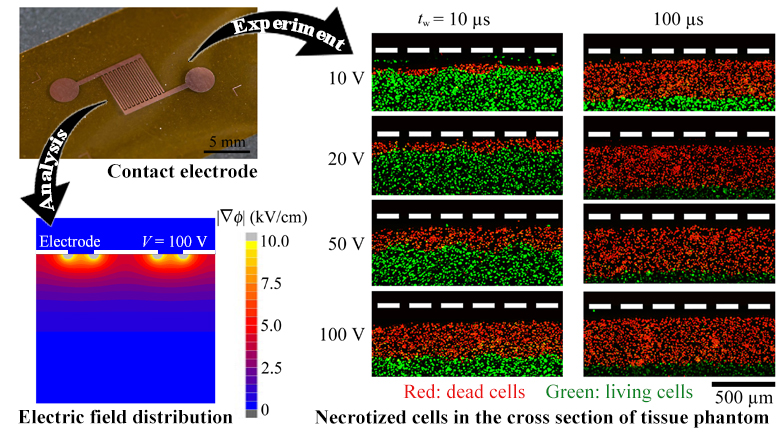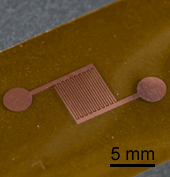
Irreversible electroporation (IRE) is a less invasive therapy to ablate tumor cells by delivering short intensive electric pulses more than a few kV via needle-like electrodes. However, general anesthesia is needed for the therapy to avoid muscle convulsions and contractions of patients although the procedure of the IRE is minimally invasive in itself. To reduce the required voltage for the IRE, a durable comb-shaped miniature electrode was designed to use in contact with the lesion surface for a new method named contact IRE.
A miniature electrode was newly fabricated by fine inkjet patterning and subsequent etching of a copper-clad polyimide film. A train of 10-µs or 100-µs long electric pulses were applied 90 times at an interval of 1 s to a tissue phantom followed by observation of its cross section for measuring the necrotized area. In order to maximize the ablation depth within a voltage limitation, two different approaches were examined: insulation of the lateral space between electrode teeth to prevent short-circuit of the electric current and administration of adjuvants to reduce the IRE threshold of the cell membrane.
Experiments using 3-D cultured cells showed that the maximum ablation depth increased with the applied voltage and reached 400 µm at 20 V. Furthermore, insulation of the lateral space between electrode teeth with a resin and administration of adjuvants to reduce the IRE threshold expanded the ablation depth by 26% and the cross-sectional ablation area by 40%.
The result showing necrosis of cells in a tissue phantom as deep as 400 µm from the surface demonstrated the feasibility of ablating cutaneous and subcutaneous tumors using the contact IRE for the surface of skin or gastrointestinal tract by applying only several tens of volts.

